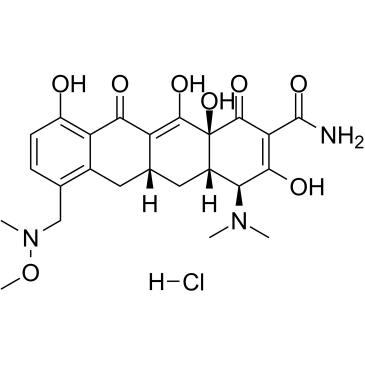| Cas No.: | 1035979-44-2 |
| Chemical Name: | Sarecycline HCl |
| Synonyms: | WC-3035; WC 3035; WC3035; P005672; P-005672; P 005672; P005672 HCl; Sarecycline hydrochloride; Seysara |
| SMILES: | CN(OC)CC1=C2C(C(C3=C(O)[C@@](C(C(C(N)=O)=C(O)[C@H]4N(C)C)=O)(O)[C@@]4([H])C([H])[C@]3([H])C2)=O)=C(O)C=C1.Cl |
| Formula: | C24H30ClN3O8 |
| M.Wt: | 523.97 |
| Sotrage: | 2 years -20°C Powder, 2 weeks 4°C in DMSO, 6 months -80°C in DMSO |
| Description: | Sarecycline hydrochloride is a narrow-spectrum tetracycline-class antibiotic. Sarecycline hydrochloride possesses anti-inflammatory properties and potent activity against Gram-positive bacteria, including activity against multiple strains of Cutibacterium acnes. Sarecycline hydrochloride interferes with tRNA accommodation and tethers mRNA to the 70S ribosome[1][2][3]. |
| In Vivo: | Sarecycline hydrochloride (0.33-9 mg/kg; i.v.) show potent activity against S. aureus in a murine neutropenic thigh infection model[1]. Animal Model: Female SD-1 mice (A murine neutropenic thigh wound infection model)[1] Dosage: 0.33, 1, 3, or 9 mg/kg Administration: Intravenously Result: Achieved a 2-log10 reduction in the bacterial burden in the thigh at a dose comparable to that of doxycycline, with ED50s of 8.23 and 8.32 mg/kg, respectively. |
| In Vitro: | Sarecycline inhibits 55 clinical isolates of C. acnes, and the MIC values for Sarecycline ranged from 0.5 to 16 µg/ml; the MIC50 was 0.5 µg/ml, and the MIC90 was 4 µg/ml. Sarecycline, exhibits activity against the macrolide-resistant organisms[1]. Sarecycline hydrochloride exhibits minimal activity against enteric aerobic Gram-negative bacteria[2]. |

 To enhance service speed and avoid tariff delays, we've opened a US warehouse. All US orders ship directly from our US facility.
To enhance service speed and avoid tariff delays, we've opened a US warehouse. All US orders ship directly from our US facility.




















